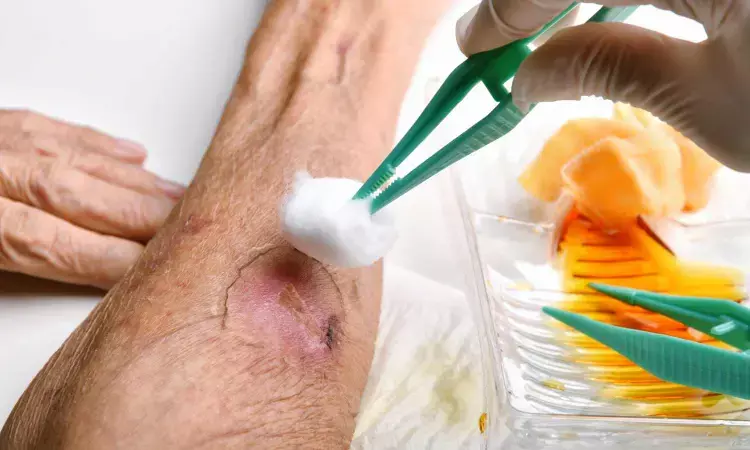- Home
- Medical news & Guidelines
- Anesthesiology
- Cardiology and CTVS
- Critical Care
- Dentistry
- Dermatology
- Diabetes and Endocrinology
- ENT
- Gastroenterology
- Medicine
- Nephrology
- Neurology
- Obstretics-Gynaecology
- Oncology
- Ophthalmology
- Orthopaedics
- Pediatrics-Neonatology
- Psychiatry
- Pulmonology
- Radiology
- Surgery
- Urology
- Laboratory Medicine
- Diet
- Nursing
- Paramedical
- Physiotherapy
- Health news
- Fact Check
- Bone Health Fact Check
- Brain Health Fact Check
- Cancer Related Fact Check
- Child Care Fact Check
- Dental and oral health fact check
- Diabetes and metabolic health fact check
- Diet and Nutrition Fact Check
- Eye and ENT Care Fact Check
- Fitness fact check
- Gut health fact check
- Heart health fact check
- Kidney health fact check
- Medical education fact check
- Men's health fact check
- Respiratory fact check
- Skin and hair care fact check
- Vaccine and Immunization fact check
- Women's health fact check
- AYUSH
- State News
- Andaman and Nicobar Islands
- Andhra Pradesh
- Arunachal Pradesh
- Assam
- Bihar
- Chandigarh
- Chattisgarh
- Dadra and Nagar Haveli
- Daman and Diu
- Delhi
- Goa
- Gujarat
- Haryana
- Himachal Pradesh
- Jammu & Kashmir
- Jharkhand
- Karnataka
- Kerala
- Ladakh
- Lakshadweep
- Madhya Pradesh
- Maharashtra
- Manipur
- Meghalaya
- Mizoram
- Nagaland
- Odisha
- Puducherry
- Punjab
- Rajasthan
- Sikkim
- Tamil Nadu
- Telangana
- Tripura
- Uttar Pradesh
- Uttrakhand
- West Bengal
- Medical Education
- Industry
Smart bandage clears new hurdle: Monitors chronic wounds in human patients: Study

Caltech professor of medical engineering Wei Gao and his colleagues are envisioning a smart bandage of the future-a "lab on skin" that could not only help patients and caregivers monitor the status of chronic wounds but also deliver treatment and speed up the healing process for those cuts, incisions, scrapes, and burns that are slow to heal on their own.
In 2023, Gao's team cleared the first hurdle toward achieving that goal by showing that a smart bandage they developed could provide real-time data about chronic wounds in animal models, while also accelerating the healing process through the timely application of medication or electrical fields to stimulate tissue growth.
Now Gao and his colleagues from Caltech and the Keck School of Medicine of USC have cleared another hurdle by demonstrating that an improved version of their bandage, which they call iCares, was able to continually sample fluid, which the body sends to wound sites as part of the inflammatory response, in 20 human patients with chronic wounds. These wounds were not able to heal either because of diabetes or poor blood circulation; the researchers also studied additional patients before and after surgery.
The smart bandage, outfitted with three different microfluidic components-miniature modules that channel and otherwise control the flow of liquids-clears excess moisture from wounds while providing real-time data about biomarkers present.
"Our innovative microfluidics remove moisture from the wound, which helps with healing. They also make sure that samples analyzed by the bandage are fresh, not a mixture of old and new fluid. To get accurate measurements, we need to sample only the newest fluid at a wound site," says Gao, who is also a Heritage Medical Research Institute Investigator. "In this way, iCares can watch in real time for important biomarkers of inflammation and infection."
Indeed, in a new paper in the journal Science Translational Medicine, Gao and his colleagues show that the smart bandage can detect molecules such as nitric oxide, an indicator of inflammation; and hydrogen peroxide, a biomarker of infection; potentially one to three days before patients experience symptoms.
In a further advance, the team has developed a machine-learning algorithm that can successfully classify the patients' wounds and predict healing time with a level of accuracy comparable to that of an expert clinician.
The bandage is composed of a flexible, biocompatible polymer strip that can be 3D printed at low cost. It integrates nanoengineered biomarker sensor array, which is disposable for hygiene and single-use applications. The system also includes a reusable printed circuit board that handles signal processing and wireless data transmission to a user interface, such as a smartphone. The triad of microfluidic modules within iCares includes a membrane that sucks wound fluid from the surface of the wound, a bioinspired component that shuttles the fluid across the device onto a sensor array where it is analyzed, and a micropillar module that carries the sampled fluid away to the outside of the bandage.
Reference:
Wang C, Fan K, Shirzaei Sani E, Lasalde-Ramírez JA, Heng W, Min J, Solomon SA, Wang M, Li J, Han H, Kim G, Shin S, Seder A, Shih CD, Armstrong DG, Gao W. A microfluidic wearable device for wound exudate management and analysis in human chronic wounds. Sci Transl Med. 2025 Apr 23;17(795):eadt0882. doi: 10.1126/scitranslmed.adt0882.
Dr Kamal Kant Kohli-MBBS, DTCD- a chest specialist with more than 30 years of practice and a flair for writing clinical articles, Dr Kamal Kant Kohli joined Medical Dialogues as a Chief Editor of Medical News. Besides writing articles, as an editor, he proofreads and verifies all the medical content published on Medical Dialogues including those coming from journals, studies,medical conferences,guidelines etc. Email: drkohli@medicaldialogues.in. Contact no. 011-43720751


